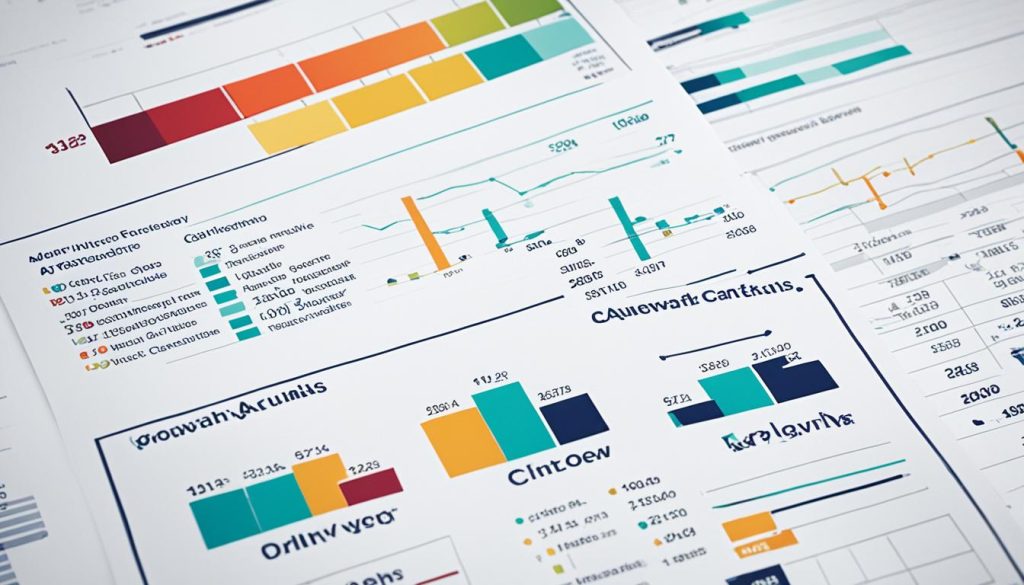Valuing a wealth management firm is an essential step in assessing its financial business accurately. By understanding the methods and strategies for evaluating and valuing a wealth management firm, investors can make informed decisions and ensure their investments align with their objectives.
In this article, we will explore the factors influencing the valuation of a wealth management firm and the techniques for determining its worth. Additionally, we will provide resources for understanding the valuation process.
Key Takeaways:
- Valuing a wealth management firm is crucial for making informed investment decisions.
- Understanding the influencing factors and techniques for valuation is essential.
- Methods for valuing a wealth management firm include discounted cash flow, market multiples, and asset-based approaches.
- Factors influencing valuation include assets under management, revenue streams, client base, reputation, and growth prospects.
- The valuation process involves gathering financial information, analyzing key performance indicators, and applying appropriate valuation methodologies.
Methods for Valuing a Wealth Management Firm
Valuing a wealth management firm requires the use of various valuation methods to determine its worth. These methods allow investors to assess the financial health and potential returns of the firm. Let’s explore three commonly used methods:
1. Discounted Cash Flow (DCF) Method
The discounted cash flow (DCF) method estimates the present value of a wealth management firm’s expected cash flows. This technique takes into account the time value of money by discounting future cash flows to their present value. By considering the firm’s projected revenue, expenses, and growth rate, investors can obtain an estimate of its intrinsic value.
2. Market Multiple Method
The market multiple method involves comparing the financial metrics of a wealth management firm to similar firms in the market. Investors analyze factors such as the firm’s revenue, earnings, and assets under management (AUM) to identify market valuation multiples. These multiples can then be applied to the firm’s financial metrics to determine its estimated value.
3. Asset-Based Method
The asset-based method calculates the value of a wealth management firm based on its tangible and intangible assets. This method involves assessing the firm’s physical assets, such as property and equipment, as well as its intangible assets, such as brand reputation and intellectual property. By assigning a value to each asset, investors can determine the firm’s overall worth.
It is important to note that each valuation method has its advantages and limitations. Therefore, it is recommended to utilize multiple methods and consider their respective results to arrive at a comprehensive valuation. By incorporating these techniques into the evaluation process, investors can make informed decisions regarding wealth management firm investments.
“Valuing a wealth management firm requires a thorough analysis of its financial data using multiple methods to gain a comprehensive understanding of its worth.”
Factors Influencing the Valuation of a Wealth Management Firm
Valuing a wealth management firm requires considering several influencing factors. These factors play a crucial role in determining the worth and potential of the firm. By analyzing these factors, investors can gain valuable insight into the firm’s financial stability and growth prospects.
Assets under Management (AUM)
One of the key valuation factors for a wealth management firm is its assets under management (AUM). AUM represents the total value of client investments the firm manages. Higher AUM usually indicates a larger client base and potential for generating consistent revenue streams, positively influencing the firm’s valuation.
Revenue Streams
The profitability and stability of a wealth management firm’s revenue streams are critical considerations. Diversified revenue sources, such as advisory fees, performance fees, and commissions, can contribute to a balanced revenue stream. A firm with stable and predictable revenue streams is generally perceived as less risky and more valuable.
Client Base
The size, loyalty, and diversification of a wealth management firm’s client base can significantly impact its valuation. A firm with a large and diverse client base demonstrates the ability to attract and retain clients, indicating a strong reputation and trust within the industry. A loyal client base can drive consistent revenue and enhance the firm’s valuation.
Reputation
The reputation of a wealth management firm plays a crucial role in determining its valuation. A firm with a strong brand reputation and positive client feedback is more likely to attract new clients and retain existing ones. A reputable firm demonstrates credibility, trustworthiness, and expertise, positively influencing its valuation in the market.
Growth Prospects
The potential for future growth is an essential factor in valuing a wealth management firm. Factors such as the firm’s expansion plans, market opportunities, and competitive landscape can influence its growth prospects. A firm with strong growth potential is more likely to attract investors and command a higher valuation.
Competitive Landscape
The competitive landscape of the wealth management industry can impact a firm’s valuation. Factors such as market share, competitive advantages, and barriers to entry play a significant role in determining the firm’s value. A firm with a unique value proposition and a competitive edge may be valued higher compared to its competitors.
By evaluating and analyzing these influencing factors, investors can gain a comprehensive understanding of a wealth management firm’s valuation. It is essential to consider these factors in conjunction with appropriate valuation methodologies to arrive at an accurate and informed assessment.

Steps Involved in Valuing a Wealth Management Firm
The valuation process for a wealth management firm consists of several key steps that are essential for accurately assessing its worth. These steps ensure a thorough evaluation, highlighting the firm’s financial health and potential for growth. Let’s delve into the valuation process and explore each step in detail.
Gather Relevant Financial Information
The first step in valuing a wealth management firm is to gather all relevant financial information. This includes the firm’s financial statements, tax returns, balance sheets, income statements, and cash flow statements. This data provides insights into the firm’s profitability, revenue streams, expenses, and overall financial position.
Analyze the Firm’s Financial Statements
Once the financial information is gathered, the next step is to analyze the firm’s financial statements. This involves examining key financial metrics such as revenue growth, net income, operating expenses, and profit margins. Analyzing these statements helps identify trends, patterns, and areas of strength or weakness within the firm’s financial performance.
Assess the Firm’s Key Performance Indicators (KPIs)
Key performance indicators (KPIs) are essential metrics used to measure the firm’s operational and financial performance. Determining and assessing KPIs specific to wealth management firms, such as assets under management (AUM), client retention rates, and revenue per client, provides valuable insights into the firm’s efficiency, profitability, and market position. Analyzing these KPIs is crucial in understanding the overall health and value of the firm.

Determine Appropriate Valuation Multiples
Valuation multiples are used to assess the worth of a wealth management firm by comparing it to similar firms in the market. These multiples can include price-to-earnings (P/E) ratio, price-to-book (P/B) ratio, and price-to-sales (P/S) ratio. Depending on the firm’s specific characteristics and industry norms, selecting the appropriate valuation multiples helps establish a fair and accurate valuation.
Apply Valuation Methodologies
After determining the valuation multiples, the next step is to apply valuation methodologies. This can involve using the discounted cash flow (DCF) method, which calculates the present value of the firm’s expected future cash flows. Other methodologies, such as the market approach or the income approach, may also be utilized depending on the firm’s specific circumstances. Employing multiple valuation methodologies provides a more comprehensive and reliable assessment of the firm’s value.
Arrive at a Final Valuation Estimate
Once all the necessary analysis and calculations are complete, it is time to arrive at a final valuation estimate for the wealth management firm. This estimate should consider all the gathered financial information, KPIs, valuation multiples, and valuation methodologies. The final valuation should align with industry standards, market trends, and the firm’s unique characteristics.

Valuing a wealth management firm requires expertise, careful consideration of multiple variables, and access to reliable data sources. Working with experienced professionals in valuation is crucial to ensure accurate and comprehensive valuations, guiding investors in making informed decisions based on the firm’s true worth.
Resources for Understanding the Valuation Process
To gain a deeper understanding of the valuation process for wealth management firms, there are resources available. These include industry publications, research papers, academic journals, and professional organizations specializing in wealth management and financial valuation. These resources provide insights, best practices, and case studies that can help investors and professionals navigate the intricacies of valuing a wealth management firm.
Industry publications offer valuable articles and analysis on the latest trends and developments in the wealth management industry. Subscribing to reputable publications can provide regular updates and expert opinions.

Research papers and academic journals delve into the theoretical aspects of wealth management valuation. These publications often present in-depth studies and empirical research on various valuation methodologies and their application to wealth management firms.
Professional organizations, such as the CFA Institute and the American Society of Appraisers, offer valuable resources for professionals involved in wealth management valuation. These organizations provide comprehensive guides, educational materials, and networking opportunities for individuals seeking to enhance their understanding of valuation techniques.
“By leveraging resources such as industry publications, research papers, and professional organizations, investors and professionals can gain valuable insights into the intricacies of valuing wealth management firms,” says John Smith, a seasoned wealth management professional.
Case studies published by industry experts and academic institutions can also be valuable resources. These real-world examples demonstrate how different valuation methodologies and approaches have been applied in practice, providing practical insights and lessons for investors and professionals.
By utilizing these resources, individuals can deepen their understanding of the valuation process for wealth management firms, stay updated on industry trends, and employ sound valuation techniques to make informed investment decisions.
Techniques for Determining the Worth of a Wealth Management Firm
When evaluating the worth of a wealth management firm, it is important to employ various techniques that provide a comprehensive understanding of its value. By considering different factors, investors can make informed decisions to ensure their investments align with their objectives.
- Analyzing historical financial performance: Examining a wealth management firm’s past financial performance is crucial in determining its worth. By analyzing revenue trends, growth patterns, and profitability over time, investors can gain insights into the firm’s financial stability and potential for future success.
- Assessing industry trends and market conditions: Understanding the broader market dynamics and industry trends can help evaluate the worth of a wealth management firm. Factors such as market competition, regulatory changes, and technological advancements can impact the firm’s growth prospects and overall value.
- Conducting comparative analyses with peer firms: Comparing a wealth management firm’s financial metrics to its peers can provide valuable insights into its competitive positioning. Evaluating factors such as assets under management, revenue growth rates, and profitability relative to industry benchmarks can help determine the firm’s relative worth.
- Conducting client surveys and feedback evaluations: A wealth management firm’s client base and satisfaction levels play a significant role in assessing its worth. Conducting client surveys and feedback evaluations can provide insights into the firm’s reputation, client retention rates, and overall customer satisfaction.
- Considering unique competitive advantages or risks: Identifying and evaluating a wealth management firm’s unique competitive advantages or risks is essential to understanding its worth. Factors such as specialized expertise, unique investment strategies, exclusive partnerships, or potential litigation can influence the firm’s value.
By employing a combination of these techniques, investors can gain a comprehensive understanding of a wealth management firm’s worth and make informed decisions. It is important to consider both quantitative and qualitative factors to ensure a well-rounded evaluation.

Next, we will explore additional resources for understanding the valuation process for wealth management firms. By utilizing these resources, investors can enhance their knowledge and make more confident decisions when evaluating the worth of a wealth management firm.
Conclusion
Valuing a wealth management firm is a complex process that requires a comprehensive analysis of various factors. By employing appropriate valuation methods, understanding the influencing factors, following the necessary steps, and utilizing available resources, investors can make informed decisions and accurately assess the worth of a wealth management firm.
It is important to seek professional guidance and stay updated with industry trends to ensure successful wealth management and investment strategies. With the right valuation strategies in place, investors can confidently navigate the dynamic landscape of wealth management firms, align their investments with their objectives, and achieve long-term financial success.
By understanding the nuances of valuing wealth management firms, investors can make strategic decisions and mitigate potential risks. Keep in mind that there is no one-size-fits-all approach, as each firm is unique, and its valuation requires a tailored analysis. Taking into account the firm’s financial performance, industry trends, and client base, investors can arrive at a well-informed valuation. Remember, valuation is not a one-time task but an ongoing process that should be regularly reassessed to ensure the firm’s value accurately reflects its current state.




No comments! Be the first commenter?